
AI’s Impact in 2024 Elections and What Voters Can Do to Protect Themselves from Disinformation
AI Election Security 2024
2024 is perhaps the biggest election year the world has ever seen, with more than 60 countries holding national elections that will impact nearly half the world’s population, per Statista.
2024 is also the year the world became more comfortable with generative AI (GenAI) as organizations started to derive business value from the technology. But enterprises aren’t the only ones using AI for impact. In fact, in the first half of the year, AI was used in one third of elections worldwide – including campaign content and deepfakes of candidates – by both politicians and foreign nation-state actors alike.
AI is also being used in the run up to the US elections and Americans are worried. A recent Pew Research Center poll found that a majority of US adults are concerned that AI will be used to create disinformation on political candidates. In January, an AI deepfake robocall impersonating President Biden circulated in New Hampshire just ahead of the primaries, urging voters not to vote. The following month, the FCC banned AI robocalls. Recently, the Office of the Director of National Intelligence warned that foreign threat actors are using AI to try to manipulate US elections, by generating AI content across text, images, audio and video. And US intelligence officials are warning that the disinformation won’t stop on election day – it may continue through Inauguration Day to raise doubts about election results.
Most worrisome: Check Point Research found a trend of threat actors focusing their efforts on the few days leading up to the election in order to prevent news agencies and political campaigns from fact checking and clearing up bad information. A recent example is a viral video purporting to show a Haitian immigrant claiming to have illegally voted in the Presidential election in Georgia, which election officials are calling fake and a work of a foreign actor.
Here are some things that voters can do to stay savvy:
- Audio deepfakes are proving to be more successful than video or image deepfakes. Pay attention to the volume, background noise, pauses, cadence, and tone the voice
- Spot video deepfakes by looking for eye blinks, a consistent skin tone, lips in sync with the audio and consistent lighting
- Verify voting location and ballot information with your state and local election officials
- Be wary of news shared on social media; verify with your trusted news organization
- Leverage trusted news sites and non-partisan tools to fact-check political information
Tips to prevent the circulation of disinformation on social media:
- Always consider the source: Double check that news and information is coming from a credible source
- Cross-check the information: See if multiple reputable media sources are sharing the same news
- Check the Date: Is it fresh news or reused material?
- Check your emotions: What type of emotion is this sparking in you? Pause, evaluate and verify before spreading further



